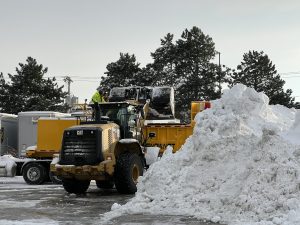 Brutal winter storms may be fun for school children excited about a snow day. But when your commercial property may be impacted, storms are by far more serious business. That’s why the Ops team at East End Group, watches weekly, daily, and hourly forecasts at all times. This includes monitoring European and GFS models for impending storms within the areas East End Group manages, along with areas we do not typically service, in the event we are called in as backup for local providers.
Brutal winter storms may be fun for school children excited about a snow day. But when your commercial property may be impacted, storms are by far more serious business. That’s why the Ops team at East End Group, watches weekly, daily, and hourly forecasts at all times. This includes monitoring European and GFS models for impending storms within the areas East End Group manages, along with areas we do not typically service, in the event we are called in as backup for local providers.
Once a storm has been identified as forming, the Ops team begins to track its progress. The first step is beginning internal and external communications. Clients are checked on and crews are alerted to what may be an impending job. 36-hours out from initial precipitation, the team has a solid idea of what is to happen, although weather is fickle and can change abruptly. At this mark, the team begins running inventory on essential supplies: salt and sand, gasoline, and brine (the liquid de-icer used in lieu of rock salt). All equipment is greased and prepped and then filled with fuel. Internal communications are checked again, ensuring all members of the team are available, and providing an anticipated start time and location. The team is always told when they will be expected to start, but not when they will end, as that is up to Mother Nature. These members are reminded to pack a ‘go bag’ with extra socks, food and water, and any other necessities for on-hand usage.
24-hours before the storm hits, work orders are officially sent and the staff gets plenty of rest knowing that once the work begins, it will not end until the job does. 12-hours before, a final check of the weather models is done. This allows for any changes in the storm to be accounted for and adjusted to. These updates give much information on a storm’s track – whether it is stalling, over or under-producing, and snowfall totals along the track. “The whole process is a chaotic dance of updating the weather and how best to service its effects,” says JP Sanieski, Vice President of Operations. During these last 24 to 12-hours, clients are regularly updated on storm changes, preparedness, and what to anticipate going forward.
By 5:30-6:30 AM during the storm, clients will be updated on road conditions, as well as the status of their property. This allows the client ample time to decide if they will delay opening or issue a closure. During the storm, regular communications are maintained so clients can plan their return to the property. Communications are not just essential with the client, but the crews and inspectors. Where necessary, teams are changed out to allow crew members to rest, ensuring safety. This is particularly important during very long weather events.
As the storm draws to an end, the team begins checking each property for a final, thorough cleanup. This can often include the clearing and salting of parking lots. Clients are conferred with to determine if any additional removal or de-icing is needed.
These final stages are dependent on communication, both internally and externally. Clients want to know what they should expect from the storm, no matter how bad. The same holds true for the staff. There are many moving parts that make these storms manageable, but communication is always valued as number one.
East End Group’s collective knowledge and experience get the job done, all the while making sure clients are abreast of the latest information. It’s a formula that works every time.

Recent Comments